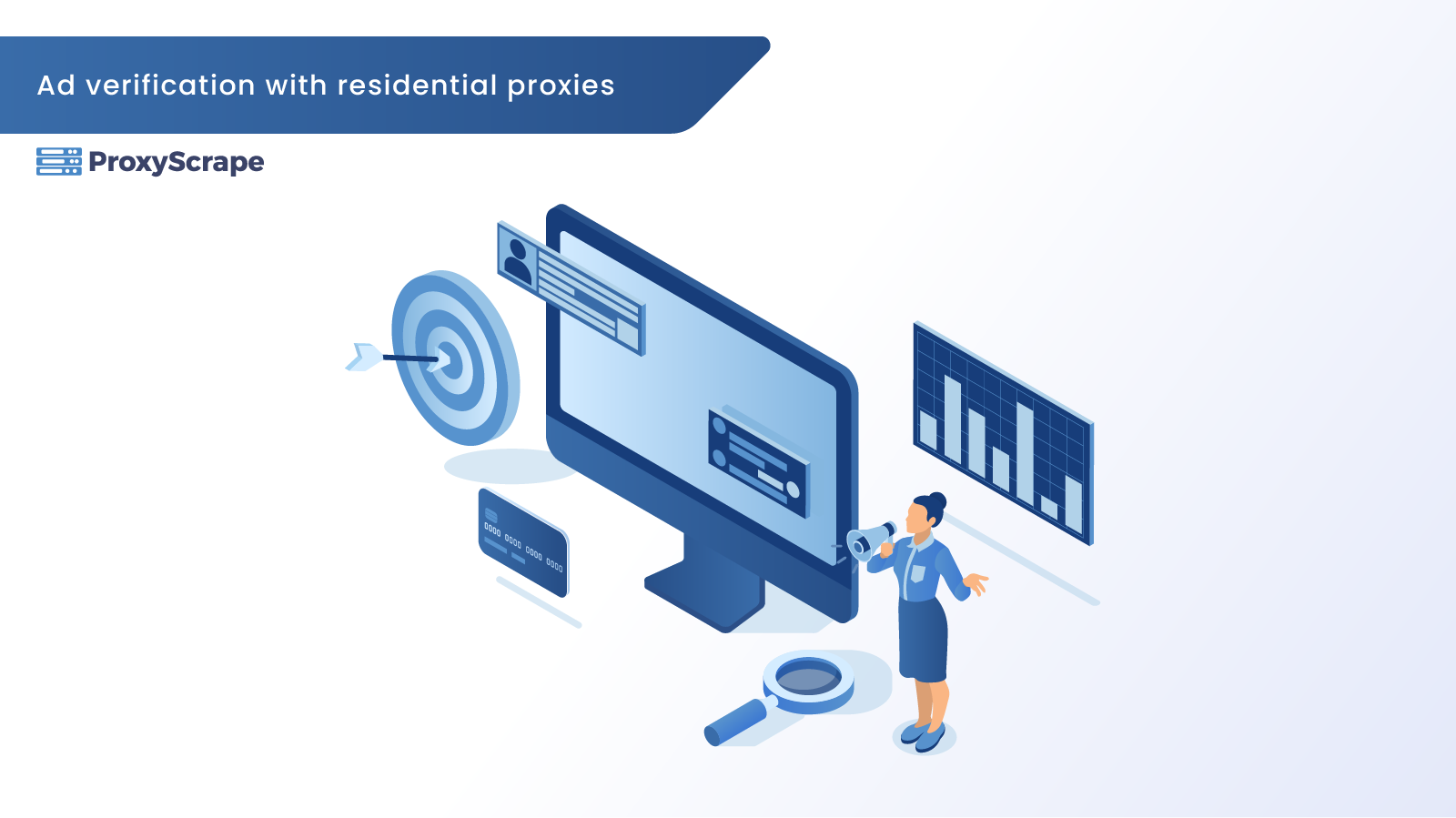Ad Verification with Residential Proxies

In an era where digital advertising has become popular among advertisers, advertisement fraud on the internet is rising. A hefty sum of the advertiser’s money is being wasted on ad impressions that do not reach the target audience, not correctly displayed in the user’s browsers, or appear on fraud websites. In 2020, for instance, the
In an era where digital advertising has become popular among advertisers, advertisement fraud on the internet is rising. A hefty sum of the advertiser’s money is being wasted on ad impressions that do not reach the target audience, not correctly displayed in the user’s browsers, or appear on fraud websites.
In 2020, for instance, the advertisers had lost $35 billion to digital ad fraud. As a consequence, the advertiser’s Return of Investment (ROI) is relatively low. As advertisers pour more money into online advertising with the escalation number of brands daily, the internet has become a breeding ground for ad fraudsters.
Therefore, an ad verification mechanism is seen as a remedy for such malicious acts. In this blog post, we will look at a powerful ad verification method with residential proxies.
Economic losses due to digital ad fraud in billion U.S. dollars

Source: https://www.statista.com/statistics/1117175/digital-ad-fraud-economic-loss-world/
What is ad fraud?
Ad fraud is any planned activity that prevents the delivery of an online ad to the intended audience or intended place. It can also be described as an attempt to deceive digital advertising networks for financial gain. Often ad fraudsters use bots, to carry out ad frauds. However, there are numerous other methods employed by ad fraudsters, and let’s dive into them in the preceding section.
What Techniques employed by ad-fraudsters?
Domain spoofing
Bidding for ad space on the web is done based on several factors such as placement type, website content, traffic quality, etc. A publisher can charge more for placement if it’s of high quality. So, Domain spoofing tricks the advertiser into thinking that they’re paying more for the ad space than the actual amount. This is carried out in several ways:
- URL substitution:
This is often the simplest form of domain spoofing. An intruder hijacks the server where the ad is hosted and substitutes a real URL with a fake one. This process tempts the advertiser into thinking that the ad is hosted on a premium site, but in reality, it was redirected to a low-quality site at the last minute.
- Cross-domain embedding
Ad fraudsters use two websites; a high inventory website with low traffic and a high traffic website with low inventory. With an iframe, a fraudster overlays the high inventory website with a low inventory website with high-traffic. As a result, the low-quality website containing phonographic or hate speech can monetize their traffic by showing their visitors ads from a brand-safe environment. This fraud mechanism misleads the advertiser.
- Malware
Ad fraudsters can generate thousands of clicks and views on paid ads with infected apps and browser extensions. On the other hand, you may often experience specific scenarios where a website successfully downloads files to your hard drive via a pop-up. Fraudsters may as skillfully inject ads into the websites that you frequently visit. The operators of these sites are not paid for such injected ads, and as a result, the fraudsters receive a handsome revenue.

Invisible and Hidden ads
These are the ads that are hidden from the user’s view even though their impressions are recorded. With Invisible ads, the fraudsters may employ techniques such as:
- hide the ad using 1* 1-pixel iframe.
- Display the ad outside the area of the browser that a user usually sees.
- Display several ads in an iframe loaded to a single slot where only the top ad is viewable.
- Display several re-sized ads.
Ad Fraud in mobile Apps
Just like the frauds with desktops and laptops, the mobile devices, too, are vulnerable to ad frauds. This is because, unlike desktops or laptops, mobile apps are rarely blocked by ad-blocking software. Let’s quickly dive into some of the ad-fraud techniques on mobile devices.
Fake users
- Click bots
These bots are designed to perform fake in-app operations. So the advertisers are tricked into believing that a massive number of genuine real users clicked their ads while the ads never reach the intended audiences.
- Click farms
Employs low-paid workers who actually click through the ads, earning CTR (Click Through Rate) money on behalf of fraudsters.
What is Ad Verification?

Ad verification is a mechanism that allows advertisers to verify if their ads are displayed; according to the expected setting, on the correct websites, in the right location of a website, and viewed by the intended target audience. The present digital-advertising technology may soon alter how marketers purchase media and how impressions are evaluated in the marketplace. It is clear with measures such as time-spent purchasing model and guaranteed viewability.
Why is Ad Verification important?
Those who acquire the maximum benefit from ad verification are:
Advertisers:
The ad-verification aims to conserve the advertiser’s precious money for ads and increase the success of marketing campaigns. It helps advertisers to verify that the ads are shown as the publisher is contracted. Also ad verification calls for advertisers to uphold transparent mechanisms in terms of how web traffic is achieved and represented.
There are a variety of aspects that can not only influence an ad’s success, but also affect the reputation of the advertising brand. For instance, if an ad is seen next to offensive material (e.g., hate speech), consumers may equate the brand with the content and may also get the misguided impression that such content is supported by the brand.
Publishers :
Ad authentication, on the other hand, aims to minimize the possibility of running malicious advertising on their pages and to provide greater control of the advertisements posted on the web.
In the past, it was the duty of the publishers’ ad ops to check ads before publishing, but due to the increase in network partners over the years, the ads became obsolete, making it impossible to control ad content reliably.
Publishers may avoid showing several types of content on their websites by introducing automatic ad-verification technologies, including:
- Malicious advertising such as URL substitution, drive-by downloads, phishing and malware ingrained into pre- and post-clicks.
- Indecent advertising (e.g., pornography or hate speech)
- Ads for products that are prohibited
- Inappropriately targeted ads
Benefits of Ad Verification
Here are some of the benefits you can have with Ad verification.
Helps to achieve the highest industry quality and clear on-site traffic acquisition proceduresPreserves marketing budgets by guaranteeing efficacy and distribution or reaching target groupsIncreases market return on investment by rising sales after adsEnsures the digital advertising market’s unhindered growthPreserves the name and credibility of a brand by ensuring that the ads are not being served on malicious sites.
How does ad verification work?
Advertisers usually use ad verification to validate that a served ad’s designated features meet their prescribed terms in the settings of the ad campaign (e.g., site, geographical, or parameters for content). To achieve this process, together with the ad (inside the ad markup), authentication tags or beacons are implemented to evaluate the content of the publisher’s website to guarantee that the website is ideal for the ad.
Then the ad-verification provider sends reports back to the advertiser or organization to evaluate positioning, results, etc. data. Usually, for a demand-side platform (DSP), the agency/advertiser would provide a different username to the ad authentication provider, while others might be incorporated with ease. The fundamental objective of ad authentication is to provide a neutral third party and validate the campaigns’ delivery independently.
The purpose of verification is not to avoid the entire display of suspicious advertising. This is because the Real-time bidding (RTB) auction has already occurred before the ad is displayed. It can still help prevent publishers with low visibility or high fraud traffic when the campaign commences by removing them (blacklisting) from the DSP.
- A website visitor arrives at a website featuring a slot for an ad.
- An ad request is submitted to several DSPs through supply-side platforms (SSPs), ad exchanges, and ad networks. The ad markup consisting of the artistic, impression-tracking pixel and ad-verification code must be configured directly on the publisher’s ad server in the case of a direct contract between the publisher and the advertiser.
- The winning ad (from the DSP, which had the highest bid) is submitted via ad markup to the publisher (creative, impression-tracking pixel, and ad-verification code).
- When the ad loads on the site, data about the website and consumer is obtained by the ad-verification code.
- The ad-verification provider then sends success reports to the advertiser, including ad placement information, viewer, interaction, etc.
- Suppose the media transaction is a direct contract between the advertiser and the publisher. In that case, the ad markup containing the ad-verification tag is returned to the browser by supply-side sites, ad exchanges, ad networks, or configured directly on the publisher’s ad server.
How can residential proxy help for ad verification?

Ad Verification with Residential Proxies
Ad verification companies often use a proxy network of large-scale magnitude to seize ad fraudsters and not reveal the fraudsters’ identity. Whenever the ad verification script connects to a malicious website, it needs to have many unique IP addresses of a large scale. Otherwise, fraudsters can detect and block the verification company from returning to the site.
One of the obstacles ad verification agencies confront in the present industry is IP ad fraudsters blocking the agencies’ IP address. Even an IP ban of minute scale can result in an ad verification service unworthy because it won’t be able to access fraudsters’ sites. This is exactly how the gambling field has ingrained into the residential proxy market.
After all, if you’re keeping ad fraudsters in restraint for more than a day, you are compelled to come under their detector. This is the primary reason why the ad verification companies use residential proxies for ad verification. These residential proxies ensure that none of the fraudsters would be able to block or restrict a 10+ million IP pool. With a revolving proxy, ad security companies can get on with their tasks specific to their job without worrying about any network blocking on mistrusted sites.
Why are residential proxies better than data center proxies for ad verification?
Deceitful sites do not want to abandon their positions and always try to deceive and block those who work against them. Although Datacenter proxies are cheaper, and popular, their IPs are very easy to recognize. If you try to track a fraudster site using a datacenter IP, you will be quickly detected and after a little while, you will be blocked.
If you have signed up with a residential proxy, now you have a pool of tons of residential proxies. Residential proxies allow you to choose a specific location (country or a city) and browse the web as a real-user in that area.
Proxies can be defined as mediators that protect users from general web traffic. They act as buffers while concealing your IP address. Proxies are alternative IP addresses assigned to users by the provider. Because it is a regular user’s IP, they will have few reasons to distrust you because you will be just like a normal residential IP owner. Given the pool’s colossal size and an opportunity to change IP addresses in small time periods, fraudsters have zero chance to seize you under their radar.
Sometimes advertisers hesitate to use residential proxies due to their somewhat high price compared to datacenter proxies. However that extra cost looks quite negligible, given the 30+% ROI loss caused by ad fraud, a $0.1 per IP tariff and $5 per gigabyte. In this scenario, selecting residential proxies over data centers would be the most cost-effective means to shield from ad fraudsters.
How ProxyScrape can help your ad verification
ProxyScrape can help you overcome the ad fraud vulnerabilities that you are currently confronted with. We provide a range of residential proxy packages that will suit your online advertising needs for reasonable prices. All our packages contain over 5 million residential pools. You also have the choice of selecting HTTP or HTTPS.
Click here for more details.
Conclusion
The demand for protection against ad fraud continues to rise as more brands are discovered each day. The ad fraudsters, too, are implementing new ways and means to carry out malicious acts with the rise in this demand.
As you have learned in this blog, residential proxies are your ultimate solution to shield against ad frauds. So if you are a digital advertiser, use residential proxies over any other method to protect from ad fraudsters.